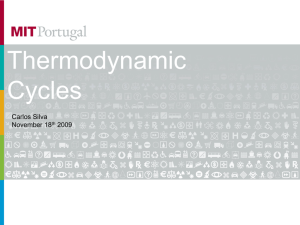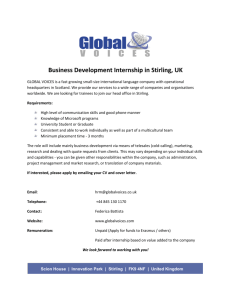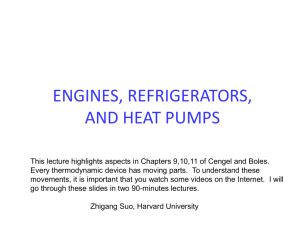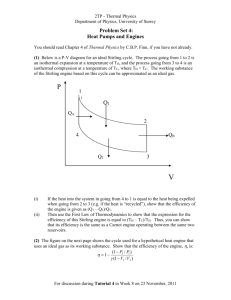Chapter 1 INTRODUCTION AND BASIC CONCEPTS
advertisement
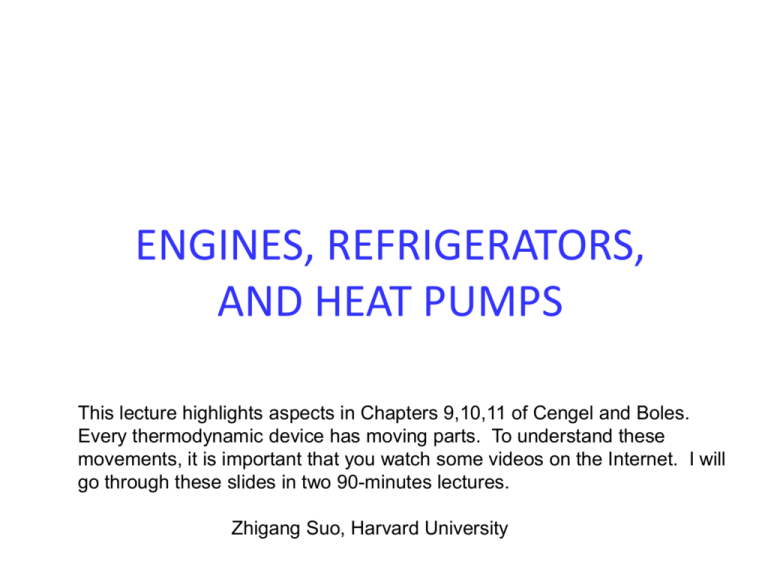
ENGINES, REFRIGERATORS, AND HEAT PUMPS This lecture highlights aspects in Chapters 9,10,11 of Cengel and Boles. Every thermodynamic device has moving parts. To understand these movements, it is important that you watch some videos on the Internet. I will go through these slides in two 90-minutes lectures. Zhigang Suo, Harvard University How humans tell each other something? • • • • The thing itself Pictures Words Equations • • • • Language Books Movies The Internet 2 Thermodynamics = heat + motion Too many devices to classify neatly • Fuel (input): biomass, fossil, solar thermal, geothermal, nuclear, electricity. • Application (output): mobile power plant (transpiration in air, land, sea), stationary power plant (electricity generation), refrigerator, heat pump. Power cycle, refrigeration cycle. • Working fluid: Gas cycle (air), vapor cycle (steam, phase change). • Fluid-solid coupling: piston engine (reciprocating, crankshaft), turbine engine (jet, compressor). • Site of burning: external combustion, internal combustion. 3 Plan • • • • • • Internal combustion engines Gas turbines Stirling and Ericsson engines Vapor power cycle Refrigeration cycle Thermodynamics in a nutshell 4 Combustion engine burns to move BOILER STEAM WATER Fayette Internal Combustion Engiine I COMBUSTION CHAMBER PISTON PISTON External combustion engine • • • Steam engine Stirling engine Ericsson engine Internal combustion engine (ICE) • • • • Otto (gasoline) engine Diesel engine Gas turbine Jet propulsion US Navy Training Manual, Basic Machines 5 Reciprocating engine also known as piston engine, converts linear motion to rotation CYLINDER PISTON CONNECTING ROD CRANKSHAFT US Navy Training Manual, Basic Machines 6 fuel-air mixture entering cylinder air entering exhaust valve closed fuel-air mixture being compressed both valves closed Fuel discharging intake from nozzle valve open piston moving down piston moving up valve tappet lifting valve cam lobe lifting valve tappet 1 cycle 4 strokes 2 revolutions INTAKE STROKE spark igniting mixture COMPRESSION STROKE both valves closed exhaust valve open intake valve closed Animated engines http://www.animatedengines.com/ piston moving up piston moving down valve tappet lifting valve cam lobe lifting valve tappet 7 US Navy Training Manual, Basic Machines POWER STROKE EXHAUST STROKE Spark-ignition engine (gasoline engine, petrol engine, Otto engine) 8 Air-standard assumptions 1. 2. 3. 4. Model the engine as a closed system, and the working fluid as air (an ideal gas). The cycle is internally reversible. Model combustion by adding heat from an external source Model exhaust by rejecting heat to an external sink 9 Cold air-standard assumption Model air as an ideal gas of constant specific heat at room temperature (25°C). 2 independent variables to name all states of thermodynamic equilibrium 6 functions of state: PTvush 4 equations of state Pv = RT ( ) h2 - h1 = cP (T2 - T1 ) u2 - u1 = cv T2 - T1 æT ö v2 2 ç ÷ s2 - s1 = cv log ç ÷ + R log v1 è T1 ø Gibbs equation ds = 1 P du + dv T T cP / cv = k, cP - cv = R, R = 0.2870kJ/kg ×K, k = 1.4 isentropic process Pvk = constant, Tvk-1 = constant, TP - k-1 k = constant 10 Thermal efficiency of Otto cycle Compression ratio: Conservation of energy: Isentropic processes: Thermal efficiency: V r = BDC VTDC ( ) qin = u3 - u2 = cv T3 -T2 , ( ) win = u2 - u1 = cv T2 -T1 , æ v ök-1 = çç 1 ÷÷ = r k-1 , T1 è v2 ø T2 hth, Otto = wout - win qin ( qout = u4 - u1 = cv T4 -T1 ( ) wout = u3 - u4 = cv T3 -T4 ) æ v ök-1 = ç 4 ÷ = r k-1 T4 çè v3 ÷ø T3 =1- T4 -T1 T3 -T2 =1- 1 r k-1 wout win 11 Otto cycle represented in planes of different variables s 3 qin 2 Pv = RT 4 qout ( u2 - u1 = cv T2 - T1 ) æT ö v2 2 ç ÷ s2 - s1 = cv log ç ÷ + R log v1 è T1 ø 1 v 12 Reciprocating engines of two types Spark-ignition engine (Otto, 1876) Compression-ignition engine (Diesel, 1892) https://ccrc.kaust.edu.sa/pages/HCCI.aspx 13 Compression-ignition engine (Diesel engine) compression ratio: cut-off ratio: Conservation of energy: Isentropic processes Thermal efficiency: r = v1 / v2 rc = v3 / v2 ( ) qin = h3 - h2 = cP T3 -T2 , ( qout = u4 - u1 = cv T4 -T1 ) wnet,out = qin - qout æ v ök-1 = çç 1 ÷÷ = r k-1 , T1 è v2 ø T2 æ v ök-1 æ ök-1 r = ç 4 ÷ = çç ÷÷ T4 çè v3 ÷ø è rc ø T3 é k 1 ê rc -1 hth, Diesel = 1 =1=1qin k T3 -T2 r k-1 êë k rc -1 qout T4 -T1 ( ) ( ) ù ú ú û 14 Plan • • • • • • Internal combustion engines Gas turbines Stirling and Ericsson engines Vapor power cycle Refrigeration Thermodynamics in a nutshell 15 Gas turbine (Brayton cycle) 4 steady-flow components: isobaric and isentropic P qin 3 2 1 4 qout 16 s Thermal efficiency of Brayton cycle Definition of pressure ratio: Conservation of energy: rp = P2 / P1 ) ( qin = h3 - h2 = cP T3 -T2 , ( ) win = h2 - h1 = cP T2 -T1 , k-1 Isentropic processes: Thermal efficiency: T2 T1 k-1 æP ö k 2 = çç ÷÷ = rP k , P è 1ø hth, Brayton = ( ) wout = h3 - h4 = cP T3 -T4 ) k-1 T3 T4 wout - win qin ( qout = h4 - h1 = cP T4 -T1 k-1 æP ö k 3 =ç ÷ = rP k çP ÷ è 4ø T -T 1 =1- 4 1 =1T3 -T2 (k-1)/k rP 17 Brayton cycle has large back work ratio win wout = T2 -T1 T3 -T4 = T1 T4 wout win 18 Intercooling, reheating, regeneration 19 Gas turbine for jet propulsion Thousands of years of history Who invented this? Hero of Alexandria (first century AD) Frank Whittle (UK), Hans von Ohain (Germany) (during World War II) 20 http://www.techknow.org.uk/wiki/index.php?title=File:Hero_4.jpg Gas turbine for jet propulsion 6 steady-flow components Propulsive force: Propulsive power: Propulsive efficiency: ( F = m Vexit -Vinlet ) WP = FV h= WP Qin 21 http://www.ae.utexas.edu/~plv955/class/propulsion/Cp_air.GIF 22 Air as an ideal gas of variable specific heat Pv = RT, R = 0.2870kJ/kg×K ( ) h = h (T ) u=u T ds = 1 P du + dv T T P s2 - s1 = s0 T2 - s0 T1 - R log 2 P1 ( ) isentropic process ( ) ( ), = P2 Pr (T2 ) P1 Pr T1 v1 v2 = ( ) vr (T2 ) vr T1 See section 7.9 for the use of this table 23 Plan • • • • • • Internal combustion engines Gas turbines Stirling and Ericsson engines Vapor power cycle Refrigeration cycle Thermodynamics in a nutshell 24 Displacer-type Stirling engine https://www.stirlingengine.com/faq/ 25 Stirling engine and regenerator (1816) reversible cycle between two fixed temperatures, having the Carnot efficiency 26 https://people.ok.ubc.ca/jbobowsk/Stirling/how.html Stirling vs. Carnot for given limits of volume, pressure, and temperature • On PV plane, the black area represents the Carnot cycle, and shaded areas represent addition work done by the Stirling cycle. • On TS plane, the black area represents the Carnot cycle, and the shaded areas represent additional heat taken in by the Stirling cycle. • The Stirling cycle and the Carnot cycle have the same thermal efficiency. • The Stirling cycle take in more heat and give more work than the Carnot cycle. Walker, Stirling Engine, 1980. 27 Work out by Stirling cycle Specific work wout = v2 ò P dv = ò v1 RTH v dv - Specific gas constant Gas v2 v1 R= Formula Air ò æv ö dv = R TH -TL log çç 2 ÷÷ v è v1 ø RTL ( ) kB mmolecule R (kJ/kgK) 0.2870 Steam H2O 0.4615 Ammonia NH3 0.4882 Hydrogen H2 4.124 Helium He 2.077 28 Ericsson engine with regenerator (1853) reversible cycle between two fixed temperatures, having the Carnot efficiency 29 Plan • • • • • • Internal combustion engines Gas turbines Stirling and Ericsson engines Vapor power cycle Refrigeration cycle Thermodynamics in a nutshell 30 Coal power station coverts coal to electricity 31 Brayton Point Power Station Sommerset, Massachusetts Mount Hope Bay http://www.clf.org/blog/clean-energy-climate-change/brayton-point-retirement-means-game-coal-new-england/ 32 Nuclear power station converts uranium to electricity Animation https://www.awesomestories.com/images/user/be4285df4b.gif 33 http://www.nuclear-power.net/nuclear-power-plant/ Nine Mile Point Nuclear Power Plant, New York Lake Ontario Cooling tower 34 Why water? Why steam? • • • • Water is cheap. Water flows! Water is a liquid at the temperature of heat sink (rivers, lakes,...). Vaporization changes specific volume greatly: a lot of work at relatively low pressure. https://www.ohio.edu/mechanical/thermo 35 Rankine cycle 4 steady-flow components: isobaric and isentropic wpump,in = h2 - h1 qboiler,in = h3 - h2 hthermal = wturbine,out - wpump,in qboiler,in wturbine,out = h3 – h4 back-work ratio = qcondenser,out = h4 – h1 wpump,in wturbine,out P qboiler,in 2 3 wturbine,out wpumo,in 1 qcondenser, out 4 s 36 Rankin cycle has small back work ratio back-work ratio = wpump,in wturbine,out dh = Tds + vdP wpump,in = h2 - h1 = P2 ò vdP P1 wturbine,out = h3 - h4 = P3 ò vdP P4 37 Rankin cycle Vapor cycle Steam turbine Small back-work ratio Brayton cycle Gas cycle Gas turbine Large back-work ratio 38 Carnot cycle is unsuitable as vapor power cycle Issues with the in-dome Carnot cycle Process 1-2 limits the maximum temperature below the critical point (374°C for water) Process 2-3. The turbine cannot handle steam with a high moisture content because of the impingement of liquid droplets on the turbine blades causing erosion and wear. Process 4-1. It is not practical to design a compressor that handles two phases. Issues with supercritical Carnot cycle Process 1-2 requires isothermal heat transfer at variable pressures. Process 4-1 requires isentropic compression to extremely high pressures. 39 Cogeneration 40 Plan • • • • • • Internal combustion engines Gas turbines Stirling and Ericsson engines Vapor power cycle Refrigeration cycle Thermodynamics in a nutshell 41 Refrigerator and heat pump 4 steady-flow components animation COPR = h -h = 1 4 Wnet,in h2 - h1 COPHP = QL h -h = 2 3 Wnet,in h2 - h1 QH 42 Selecting Refrigerant 1. 2. 3. 4. 5. 6. • • • Large enthalpy of vaporization Sufficiently low freezing temperature Sufficiently high critical temperature Low condensing pressure Do no harm: non-toxic, non-corrosive, non-flammable, environmentally-friendly Low cost R-717 (Ammonia, NH3) used in industrial and heavycommercial sectors. Toxic. R-12 (Freon 12, CCl2F2). Damage ozone layer. Banned. R-134a (HFC 134a, CH2FCF3) used in domestic refrigerators, as well as automotive air conditioners. 43 44 45 Plan • • • • • • Internal combustion engines Gas turbines Stirling and Ericsson engines Vapor power cycle Refrigeration cycle Thermodynamics in a nutshell 46 Brayton cycle Rankin cycle Refrigeration cycle Jet propulsion, power station Internal combustion Gas cycle Gas turbine Compressor Large back-work ratio Power station External Combustion Vapor cycle Steam turbine Pump Small back-work ratio Refrigerator, heat pump Electricity Vapor cycle No turbine Vapor compressor No back work wout win 47 https://flowcharts.llnl.gov/ 48 Pure substance T liquid weights vapor gas P = 0.1 MPa liquid s fire 2 independent variables to name all states of thermodynamic equilibrium 6 functions of state: PTvush 4 equations of state Incompressible liquid v = constant ( u2 - u1 = cv T2 - T1 ) æT ö s2 - s1 = cv log çç 2 ÷÷ è T1 ø h = u + Pv liquid-gas mixture ( ) v = (1 - x ) v f (T ) + xvg (T ) u = (1 - x ) u f (T ) + xug (T ) s = (1 - x ) s f (T ) + xsg (T ) h = (1 - x ) h f (T ) + xhg (T ) P = Psat T ideal gas Pv = RT ( u2 - u1 = cv T2 - T1 ) æT ö v s2 - s1 = cv log çç 2 ÷÷ + R log 2 v1 è T1 ø h = u + Pv 49 Concepts and definitions Isolated system Quantum states of an isolated system Fundamental postulate States of thermodynamic equilibrium Functions of state Phases Number of quantum states of an isolated system: W Entropy of an isolated system: S = kB logW Isolated system generates entropy. Irreversibility Isolated system conserves energy and volume: U,V Model a closed system as a family of isolated systems: S (U ,V ) Definition of temperature (Gibbs equation 1): Definition of pressure (Gibbs equation 2): Definition of enthalpy: Definition of Helmholtz function (free energy): Definition of Gibbs function: Definition of heat capacities: ( 1 ¶S U ,V = T ¶U ) ( P ¶S U ,V = T ¶V ) H =U + PV F =U -TS G =U -TS + PV CV = ( ¶U T ,V ¶T ), CP = ( ¶H T ,P ¶T ) 50 Theory of everything the world according to entropy • • • • • • • • • • Entropy Equilibrium Irreversibility Temperature, energy Pressure, volume Phases Ideal gas Osmosis Turbines, compressors, throttling valves, heat exchangers, diffusers, nozzles Engines, refrigerators, heat pumps 51 Summary • Engine converts fuel to motion. • Refrigerator and heat pump use work to pump heat from a place of low temperature to a place of high temperature. • Many ideal cycles are internally reversible, but externally irreversible. • Stirling and Ericsson cycles are internally and externally reversible, so they have the same thermal efficiency as the Carnot cycle. • Use ideal-gas model to analyze gas as working fluid. • Use property table to analyze vapor as working fluid. • Model piston engine as a closed system (Otto, Diesel, Stirling, Ericsson). • Model turbine (or compressor) device as steady-flow components in series (Brayton cycle, Rankine cycle, refrigeration cycle). 52
